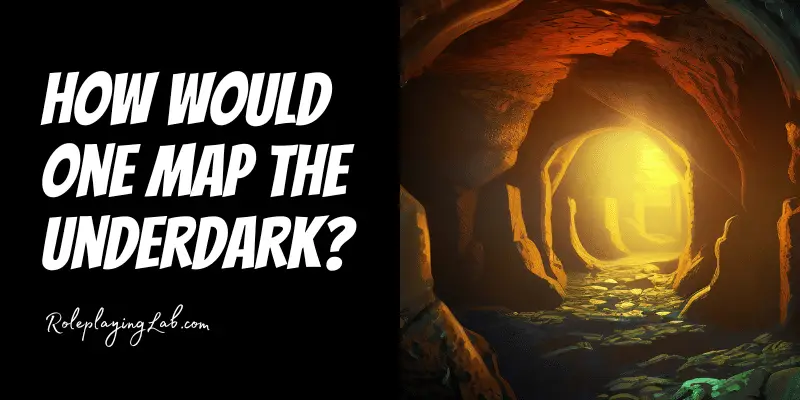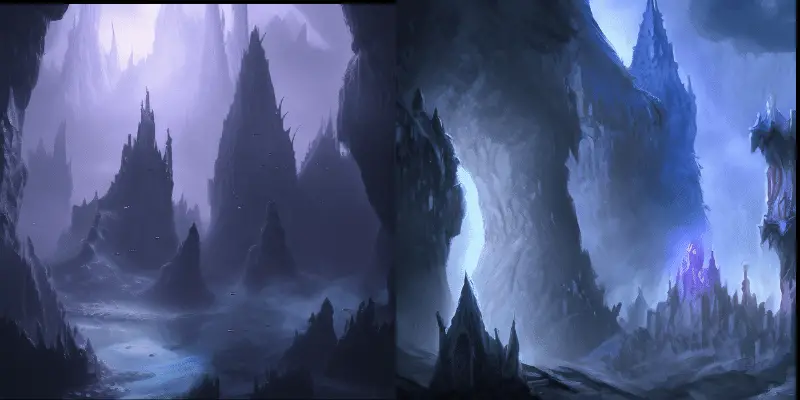The Underdark is a vast and treacherous subterranean world, filled with dangerous creatures and ancient secrets.
As a DM, creating a map of this uncharted realm seems impossible.
How would one map the Underdark?
You can map the Underdark by abstract mapping, incomplete mapping, following NPC-directed mapping, using available free maps, or creating your own map using AI tools. There is no official DND Underdark map.
In this post, we’ll explore some ideas and considerations for mapping the Underdark in your D&D campaign.
Is It Possible To Map the Underdark?

No, because it’s a system of caves and tunnels that is ever-changing as large, earth-burrowing monsters traverse it.
The Underdark is home to many dangerous and mysterious creatures that can make exploration and mapping a dangerous task. That being said, some partial mapping is certainly possible.
And mapping it can be helpful to set the stage for adventures.
As a DM, it’s up to you to decide how much of the Underdark you want to map out and how much you want to leave to the player’s imagination.
4 Ways To Map the Underdark
As a Dungeon Master (DM), there are at least four ways to approach mapping the Underdark.
Your four options:
- Abstract Mapping
- Vague and Incomplete Mapping
- Mapping from NPC Knowledge
- The Charm of the Unknown
1) Abstract Mapping
One approach to mapping the Underdark is to create an abstract map, similar to a subway map.
This type of map would feature labeled points connected by lines, indicating tunnels or portals. Color coding could be used to differentiate between different means of connection.
Keep in mind that most of the routes in the Underdark are portals, not tunnels.
Players will need to learn how to detect and activate these portals to fully explore the Underdark.
2) Vague and Incomplete Mapping
Another option is to create a vague and incomplete map.
Because of the three-dimensional nature of the Underdark, it’s not as easy to depict as the Overworld.
Rather than attempting to map every detail, consider creating a partial map that gives players a sense of what’s out there.
This could include information on known landmarks, such as caverns, forts, or underground lakes.
And approximate distances between them.
Leave unknown areas marked with question marks or warnings of danger to encourage players to explore and discover new areas.
3) Mapping from NPC Knowledge
Another approach to mapping the Underdark is to have NPCs provide players with a general idea of where they should be heading.
This is especially useful if players are unfamiliar with the Underdark.
Also, in this case, the players don’t have any in-game reason to know the terrain.
The caveat here is that players may miss out on unexpected encounters and hidden treasures if they only stick to the path laid out by NPCs.
4) The Charm of the Unknown
It’s important to remember that the Underdark is an uncharted and dangerous world.
Players may be used to having detailed maps to navigate the Overworld, but the Underdark is different.
The lack of a complete map can create a sense of uncertainty and danger, which can add to the excitement and immersion of the game.
Encourage players to think creatively and use their own skills to navigate in this hostile environment.
Tools To Map the Underdark
Mapping the Underdark is easier with several map-making tools.
Here are a few options:
- Cartography Tools – Consider using mapping software like Campaign Cartographer or Inkarnate to create detailed maps of the Underdark. These tools allow you to create custom maps with detailed terrain, landmarks, and notes.
- AI Text-to-Image Tools – AI tools like Jasper and Midjourney use natural language processing to generate realistic images from textual descriptions. These tools can be especially helpful for generating images of unique Underdark landscapes or creatures that may be difficult to draw on your own.
- AI Chatbots – Chatbots like ChatGPT and Jasper can be useful for describing the Underdark in detail. These chatbots use natural language processing to generate descriptions of different Underdark environments, creatures, and encounters. You can even use them to generate random encounters or plot twists to keep your players on their toes.
With these tools, you can create detailed and immersive maps of the Underdark.
As an example, here is a description you can use to introduce your players to this setting:
As the last of you descends into the dark fissure in the earth, the world outside disappears.
The Underdark stretches out before you in a seemingly endless maze of caverns and tunnels, twisting and turning in every direction, inviting you further and further into the darkness.
As you step onto the cavern floor, you feel the rough and jagged surface of the rocks beneath your feet, damp with the cool moisture of the underground.
The air is thick and heavy, with a pungent aroma that fills your nostrils.
You can smell the dampness, the mold, the minerals, and something else.
Something that smells like a combination of rotting vegetation and animal musk.
Despite the darkness, you can hear the sound of water dripping and running through small rivulets, echoing off the cavern walls.
In the distance, you can hear strange and unfamiliar sounds; a cacophony of growls, hisses, and screeches, punctuated by the skittering of countless feet.
The air is alive with movement and activity, and you can feel the weight of it all around you.
Above, the ceiling disappears into a black void, but in the dim light of your torches, you can see the glint of something reflecting in the distance, as if a hidden world of wonders and terrors were lurking just beyond the edges of your vision.
The shadows shift and twist, playing tricks on your eyes, and you can feel a sense of unease creeping over you.
You’ve entered the Underdark, and the journey ahead will be long and treacherous, with unknown dangers lurking around every corner.
But for now, you can only move forward, following the winding tunnels and hoping to find a way out before it’s too late.
While tools can be helpful, don’t be afraid to use your own creativity and imagination to bring this unique and treacherous world to life.
Where To Find Maps of the Underdark
You can find unofficial maps of the Underdark on Pinterest and on an endless list of personal websites.
The best place right now is Pinterest, where you can find 160 different map versions of the Underdark.
You can easily find free maps of the Underdark by doing a quick search online.
You can try searching for “free Underdark map” or “D&D Underdark map” to find a variety of options.
It’s a good idea to make sure that the maps you use are appropriate for your campaign and match the lore and world-building of your setting.
Even better, you can one of the AI tools we mentioned earlier to custom-make your own.
Here are free Underdark maps and images for you:


FAQ Section
I thought I would include this FAQ section to answer some of the most frequently answered questions.
Is There a Map of the Underdark?
There is no official map of the D&D Underdark.
However, there are several unofficial maps of the Underdark available online. Mapping the Underdark can be a difficult task due to its ever-changing and treacherous nature.
Where Is the Underdark in D&D?
The Underdark is a subterranean realm in the world of Dungeons & Dragons, located deep beneath the surface of the earth.
You can’t teleport to it because it is always shifting and changing.
What Are the Areas of the Underdark?
The Underdark is divided into several major domains.
Those domains include the Buried Realms, the Earthroot, the Darklands, the Deep Wastes, the Northdark, the Glimmersea, Old Shanatar, and Great Bhaerynden.
Many of the sentient races that inhabit the Underdark, such as the drow and duergar, have established cities and settlements within this uppermost layer.
The deeper layers are home to more dangerous and powerful creatures.
How Many Miles Underground Is the Underdark?
While the exact extent of the Underdark remains a mystery, it is estimated to be at least 26 miles deep, with rumors of unexplored caverns reaching depths of up to 40 miles.
Despite its immense size, most of the known areas of the Underdark are located within the first 10 miles of the surface.
This is partly because the closer the Underdark is to the surface, the easier it is for creatures to navigate and for natural light to filter through.
Before you go, check out this good video to help you understand and map the Underdark:
Final Thoughts: How Would One Map the Underdark?
Maps are perfect visual enhancements to your DND campaigns.
But they can be a pain in the butt to find or make for yourself. That’s why I’ve been diligently crafting and collecting the best free DND maps.
Check out some of my galleries below.
Other Related Posts:
